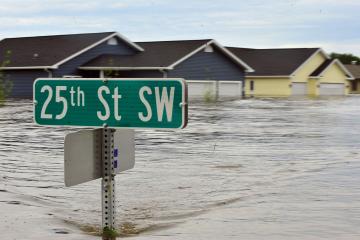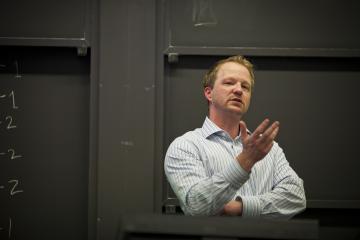
Opportunities for state and local policy responses to climate change: A recap from the State and Local Webinar Series

Reducing emissions within North America is essential to addressing the global challenges of poverty and climate change. Within the region, structural disparities and discrimination have led to low-income populations and people of color disproportionately experiencing a range of climate change-related hazards, including air pollution, water pollution, and elevated risk of harm from extreme heat and weather events.
State and local governments are attuned to how policy questions uniquely manifest for their communities. As such, they can be well positioned to provide immediate, context-relevant responses to address the challenges of climate change. To highlight the momentum of efforts around climate change and pollution mitigation, examples of current state and local interventions, and opportunities for collaboration between researchers and state and local agencies, J-PAL North America held a webinar on October 7, 2020 titled “State and Local Policy Responses to Climate Change.”
The webinar featured Fiona Burlig (University of Chicago), Zoe Davis (Climate Ready Boston, City of Boston), James Goldstene (California Air Resources Board (CARB)), and Katrina Jessoe (University of California, Davis).
Collaborative partnerships with state and local entities
In her presentation on researcher-practitioner partnerships for developing climate change interventions, Katrina Jessoe, Associate Professor at the Department of Agricultural and Resource Economics at UC Davis, stated that “through partnerships, we can take stock of impacts, cost effectiveness, and how the benefits and costs of policies are distributed.”
To illustrate the value of partnerships between researchers, policymakers, and implementers, Jessoe discussed her randomized evaluation with a California utility company. This project assesses the impact of a water conservation instrument on energy use and its cost effectiveness in conserving energy. Jessoe also discussed her research on water resources in San Joaquin, CA. This evaluation will measure the cost of droughts on access to drinking water and the quality of drinking water in disadvantaged communities. Measuring water in these communities is challenging because many people access water from domestic wells or small systems that are not subject to the same federal oversight as public systems. Collaboration with state and local agencies that collect water quality and quantity data from these systems can help in improving our understanding of how droughts impact water quality and access.
Using data to shape climate policies
Fiona Burlig, Assistant Professor at the Harris School of Public Policy at the University of Chicago, and James Goldstene, a vehicle program specialist at CARB and a professor in the Environmental Studies department at California State University–Sacramento, discussed their ongoing evaluation measuring the impact of different compliance strategies on the emissions from heavy-duty trucks. CARB regularly conducts screenings of heavy-duty vehicles operating in California but due to the high volume of vehicles, it is important to detect and address regulatory violations efficiently. In California, air pollution disproportionately affects low-income communities. This means that strategies for ensuring compliance with standards for particulate emissions are one important part of broader efforts to improve environmental justice outcomes in the region.
Goldstene discussed solutions that require both engineering and behavioral solutions. For example, making an engine work more efficiently, reducing carbon intensity, or identifying other technological improvements are all strategies that can help improve air quality. However, these strategies are only part of a full set of solutions. According to Goldstene, economists’ research about human behavior can complement technological improvements by supporting behavior changes required when adopting new technology, as well as encouraging people to examine the way they live and make other types of changes to reduce their own carbon footprints.
Zoe Davis, the Climate Resilience Project Coordinator at Climate Ready Boston, stressed that resilience planning should be holistic and inclusive in its approach, should account for the intersectionality of multiple risks (54:05), and should draw on data (57:25). She shared that the Climate Ready Boston initiative was developed by the City of Boston to prepare for the long-term impacts of climate change and was designed based on data from a detailed report by the Boston Research Advisory Group. The report used information from climate models to understand the impacts of stormwater, coastal flooding, and extreme heat. Davis stated that data has been critical in determining the time horizons for implementing coastal planning and other resilience solutions.
Centering priority communities in climate change responses
Zoe Davis highlighted the importance of centering marginalized communities and priority populations throughout the process and into the outcome of the planning in climate change initiatives (1:01:00). She states,
Although we are looking towards the future when considering climate change, we must be cognizant of the fact that the effects of climate change are being felt today. It is also important to reflect the daily lives of priority communities into the development of climate adaptation interventions so they work for actual people. [We must] recognize the history of intentional disinvestment in communities of color and in immigrant communities and make sure that this fact is reflected in the work for climate adaptation.
Davis recommended recognizing community expertise, power, and knowledge with processes of co-creation, where processes and solutions are built in tandem with community partners. For example, in early planning phases, it can be valuable to procure services from within communities that will be affected by the projects being planned (1:02:24). This can mean that residents will be able to connect with project team members who are familiar with their neighborhood, understand their values, and will make sure their voices are heard.
James Goldstene also highlighted the importance of soliciting input from communities (1:04:55):
One of the things that we’re always paying attention to is making sure that communities that have a disproportionate burden of pollution are able to communicate with us. We have relationships all over the state with community groups… we have a whole office or division set up to reach out to communities that are disproportionately impacted [by] air and climate pollutants.
Fiona Burlig discussed how inclusive, informative measurement is key for understanding impacts and designing solutions that address the needs priority communities (1:06:51):
Measurement here is really key. It’s really hard to understand how to effectively design an intervention if we can’t observe what’s happening on the ground. [Often,] communities of color and low-income communities are also underserved by the same measurement resources that help us to inform effective solutions. If, for example, I’m interested in using pollution monitoring and none of the monitors sit in a low-income community, then… it’s difficult for me to address a problem that I can’t see. One set of solutions to this is developing innovative ways to do new measurement, like we’re doing with CARB, [and leveraging] satellite data and new sources of information.
Burlig also highlighted how partnerships between researchers and policymakers are helpful in understanding not just average impacts, but also in measuring and understanding how interventions have different levels of effectiveness in different settings (1:08:10).
Katrina Jessoe also emphasized the importance of measurement, and reflected on the role of economists in helping policymakers and communities (1:10:10):
If we’re trying to understand climate impacts, mitigation options, or ways of adaptation, economists can help with research design: [designing] an evaluation strategy to use data and answer the question that we’re after.
To learn more about J-PAL North America’s work in Environment, Energy, and Climate Change, read about our work or contact J-PAL North America Environment, Energy, and Climate Change Sector Lead Erin Graeber.



